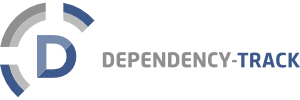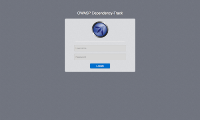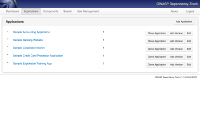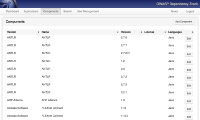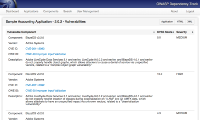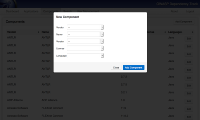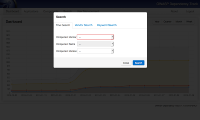This site is the archived OWASP Foundation Wiki and is no longer accepting Account Requests.
To view the new OWASP Foundation website, please visit https://owasp.org
Difference between revisions of "OWASP Dependency Track Project"
(partial content updates for 3.0.0) |
(updated description) |
||
| Line 7: | Line 7: | ||
==OWASP Dependency-Track== | ==OWASP Dependency-Track== | ||
| − | + | Modern applications leverage the availability of existing components for use as building blocks in application development. By using existing components, organizations can dramatically decrease time-to-market. Reusing existing components however, comes at a cost. Organizations that build on top of existing components assume risk for software they did not create. Vulnerabilities in third-party components are inherited by all applications that use those components. The [[OWASP Top Ten]] (2013 and 2017) both recognize the risk of [[Top 10 2013-A9-Using Components with Known Vulnerabilities|using components with known vulnerabilities]]. | |
| − | + | Dependency-Track is a Software Composition Analysis (SCA) platform that keeps track of all third-party components used in all the applications an organization creates or consumes. It integrates with multiple vulnerability databases including the [https://nvd.nist.gov/ National Vulnerability Database] (NVD), [https://nodesecurity.io/ Node Security Platform] (NSP), and [https://vulndb.cyberriskanalytics.com VulnDB] from [https://www.riskbasedsecurity.com Risk Based Security]. Dependency-Track monitors all applications in its portfolio in order to proactively identify vulnerabilities in components that are placing your applications at risk. | |
| − | + | Dependency-Track is designed to be used in an automated DevOps environment where [[OWASP Dependency Check|Dependency-Check]] results or specific BOM (Bill of Material) formats are automatically ingested during CI/CD. Use of the [https://plugins.jenkins.io/dependency-check-jenkins-plugin Dependency-Check Jenkins Plugin] is highly recommended for this purpose and is well suited for use in Jenkins Pipeline. In such an environment, Dependency-Track enables your DevOps teams to accelerate while still keeping tabs on component usage and any inherited risk. | |
| − | + | Dependency-Track can also be used to monitor vulnerabilities in COTS (commercial off-the-shelf) software. | |
| − | |||
| − | |||
| − | |||
| − | |||
| − | |||
| − | |||
| − | |||
| − | |||
| − | |||
==Licensing== | ==Licensing== | ||
Revision as of 23:53, 8 November 2017
OWASP Dependency-TrackModern applications leverage the availability of existing components for use as building blocks in application development. By using existing components, organizations can dramatically decrease time-to-market. Reusing existing components however, comes at a cost. Organizations that build on top of existing components assume risk for software they did not create. Vulnerabilities in third-party components are inherited by all applications that use those components. The OWASP Top Ten (2013 and 2017) both recognize the risk of using components with known vulnerabilities. Dependency-Track is a Software Composition Analysis (SCA) platform that keeps track of all third-party components used in all the applications an organization creates or consumes. It integrates with multiple vulnerability databases including the National Vulnerability Database (NVD), Node Security Platform (NSP), and VulnDB from Risk Based Security. Dependency-Track monitors all applications in its portfolio in order to proactively identify vulnerabilities in components that are placing your applications at risk. Dependency-Track is designed to be used in an automated DevOps environment where Dependency-Check results or specific BOM (Bill of Material) formats are automatically ingested during CI/CD. Use of the Dependency-Check Jenkins Plugin is highly recommended for this purpose and is well suited for use in Jenkins Pipeline. In such an environment, Dependency-Track enables your DevOps teams to accelerate while still keeping tabs on component usage and any inherited risk. Dependency-Track can also be used to monitor vulnerabilities in COTS (commercial off-the-shelf) software. LicensingOWASP Dependency-Track is licensed under the Apache 2.0 license.
|
Quick DownloadDependency-Track is available as a Docker container and a deployable WAR. News and Events
Features
PresentationIntroducing OWASP Dependency-Track (on SlideShare) OWASP Dependency-Track (on YouTube) DocumentationDependency-Track Project Wiki on GitHub Project LeaderRelated ProjectsClassifications
|
- What are the system requirements?
- Dependency-Track requires Java 8 or higher and can run on any Servlet 3.1 container such as Tomcat 8.5 and higher. Dependency-Track may also be used with Docker.
- What type of database is used?
- Dependency-Track embeds the H2 database engine. A standalone database server may optionally be used.
- What vulnerability datasources are supported
- National Vulnerability Database (NVD), Node Security Platform (NSP), and VulnDB (from Risk Based Security). Private vulnerabilities can also be added manually or via the REST API.
- How often are the datasources refreshed?
- The NVD and NSP sources are updated every 24 hours. VulnDB is also refreshed every 24 hours, but requires the use of VulnDB Data Mirror.
- What is the NVD mirror feature?
- For organizations that run Dependency-Check, it is possible to specify an alternate URL for the NIST/NVD data. This allows organizations with many Dependency-Check instances to take advantage of an internal mirror for faster access. The NIST/NVD data feed can be used by specifying http://HOSTNAME/CONTEXT/nist/FILENAME. For example: http://localhost:8080/dtrack/nist/nvdcve-2.0-2002.xml.gz. The NVD mirror is automatically updated every 24 hours.
This project would not be possible without the existence of the OWASP_Dependency_Check project. Special thanks to Jeremy Long and the Dependency-Check core team for their hard work.
Dependency-Track Core Team
- Steve Springett
Past Contributors
- Nikhil Chitlur Navakiran (initial 1.0.0 release)
Sponsors
OWASP Dependency-Track is an open source project, created by people who believe that the knowledge of using vulnerable components should be accessible to anyone with a desire to know. By supporting this project, you'll allow the team to outsource testing, infrastructure, further research and development efforts, and engage in outreach to various communities that would benefit from this technology.
As of November 2017, the priorities are:
- Complete VulnDB mirroring
- Create dashboard
- Complete widgets by incorporating metrics
- Complete CycloneDX and SPDX import support
- Release v3.0.0 in Q1 2018
Feedback
Please use the Dependency-Track mailing list for feedback:
- What you like?
- What you don't like?
- What could be improved?
- v1.0.0 (19 Feb 2015)
- Initial general availability release.
| PROJECT INFO What does this OWASP project offer you? |
RELEASE(S) INFO What releases are available for this project? | |||||||||||||||||||||||||||||||||||||||
|---|---|---|---|---|---|---|---|---|---|---|---|---|---|---|---|---|---|---|---|---|---|---|---|---|---|---|---|---|---|---|---|---|---|---|---|---|---|---|---|---|
|
| |||||||||||||||||||||||||||||||||||||||

